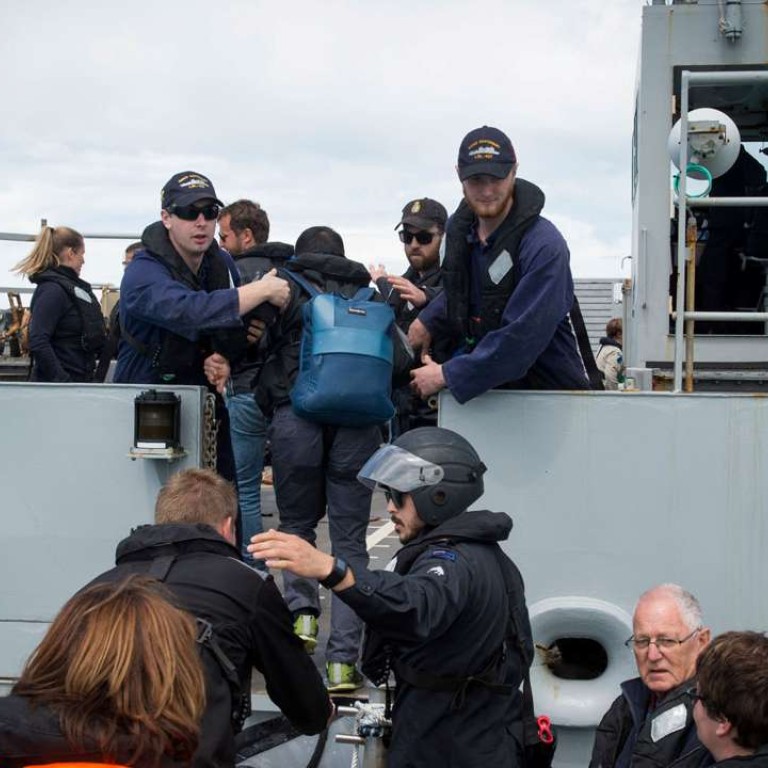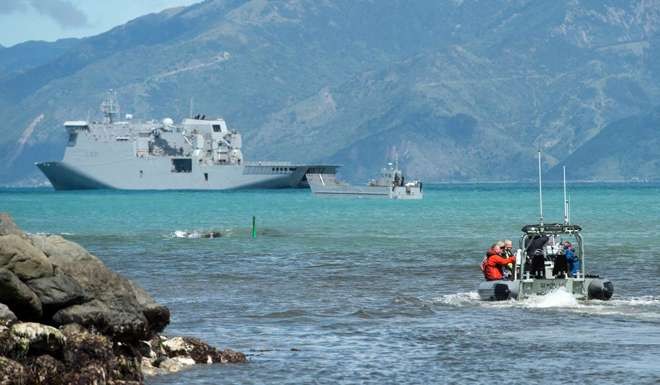
Tourists escape quake town as first US warship to visit New Zealand in 30 years joins relief efforts
The visit by the US ship is significant because it ends a three-decade-old military stalemate between the countries that was triggered when New Zealand banned nuclear warships
Rescue efforts after a devastating earthquake in New Zealand intensified Wednesday as a fleet of international warships began arriving in the disaster zone.
Vessels from the United States, Canada and Australia were also steaming toward the town, which bore the brunt of the seismic jolt that hit just after midnight on Monday.
The ships were due in Auckland this week for celebrations marking the New Zealand navy’s 75th anniversary but instead diverted to the disaster zone.




A further three New Zealand warships are also involved in the operation and Wellington has accepted unspecified aid from the Japanese and Singapore militaries in the wake of the quake that claimed two lives and caused massive infrastructure damage.
The Sampson is the first US warship to visit New Zealand waters in 33 years, ending a ban sparked by a Cold War-era diplomatic spat over Wellington’s ban on nuclear-powered vessels.
US Secretary of State John Kerry said on a visit to New Zealand on Sunday that its presence was a historic moment marking “the normalisation of our security cooperation”.

The international rescue mission’s top priority was to evacuate tourists from Kaikoura, which has been cut off after huge landslides severed road and rail access.
The town has a population of 2,000 bolstered by tourists, mostly international backpackers attracted by the area’s popular whale-watching cruises.
The last of the trapped holidaymakers boarded the navy ship HMNZS Canterbury late Wednesday.
“We got them all out, it was a superhuman effort,” Red Cross spokesman Simon Makker said.
“The last of them were cheering and dancing down the street on their way out. It was pretty cool.”
New Zealand military helicopters on Tuesday airlifted around 200 of the 1,200 trapped holidaymakers to nearby Christchurch.
About 125 Chinese tourists trapped there were evacuated to Christchurch by private helicopters chartered by the Chinese Consulate-General on Monday and Tuesday.



The tremor, one of the most powerful ever in the quake-prone South Pacific nation, has been followed by more than 1,700 aftershocks, complicating relief efforts.
The quake triggered numerous landslides that dumped mountains of rocky debris on a main highway and ripped railway tracks 10 metres course, while huge fissures opened up in roads and houses were rocked off their foundations.
New Zealand’s official GeoNet said reconnaissance flights had noted between 80,0000 to 100,000 landslips.
“The landslides that have occurred as a result of the earthquake remain dangerous. Material can move at any time,” it said in warning people to be cautious.
Prime Minister John Key said rescuers would deliver much-needed supplies to the town before starting a clean-up that was likely to cost billions of dollars.
The quake was felt across most of the country, causing severe shaking in Wellington, about 250 kilometres away.
Streets and footpaths in areas of the capital remained cordoned off Wednesday due to the danger of falling debris from several office buildings that sustained serious damage.
The Defence Department’s city centre headquarters has reportedly been rendered uninhabitable, while officials fear one office block could collapse entirely.
“The building is at significant risk of collapse so currently police and fire are conducting operation to seal off the area,” NZ Fire Service regional commander Brendan Nally told commercial radio.
The tremor also ignited painful memories for residents of Christchurch, which was devastated five years ago by a 6.3 tremor that killed 185 people.
New Zealand is on the boundary of the Australian and Pacific tectonic plates, which form part of the so-called “Ring of Fire”, and experiences up to 15,000 tremors a year.

.png?itok=arIb17P0)